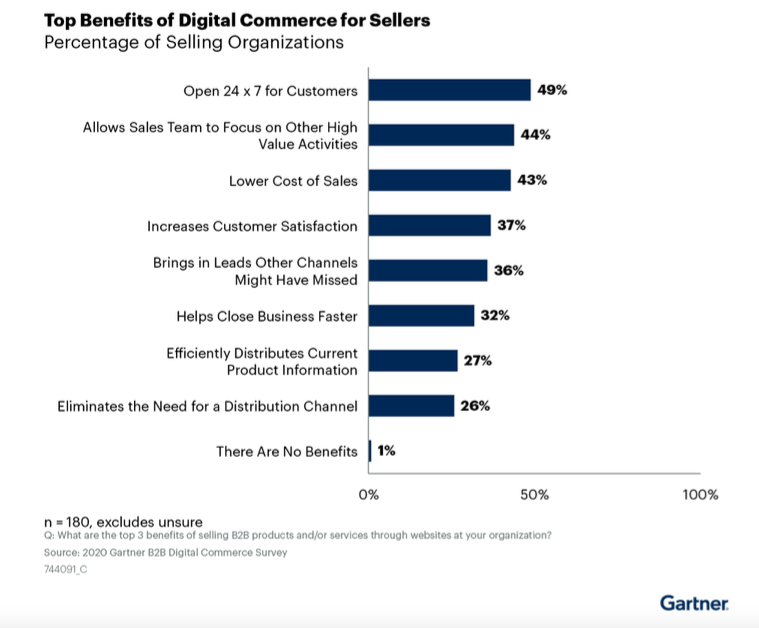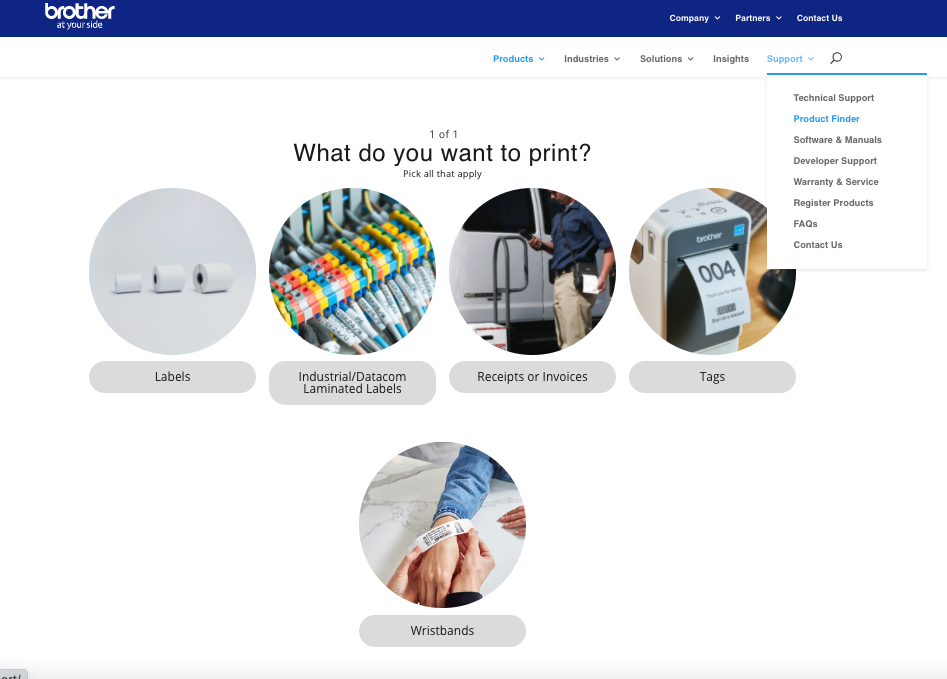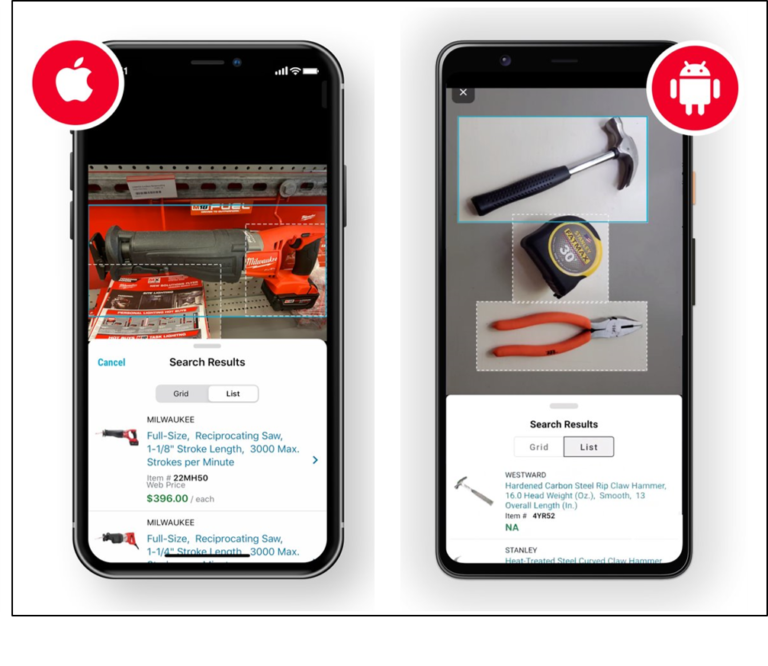Complexity. Friction. Back and forth.
Those are some of the words that come to mind when you think of traditional B2B selling.
Isn’t it ridiculous?
These words shouldn’t describe a multi-trillion-dollar industry.
And that needs to change. It’s no longer an option. It’s time for B2B sellers to prioritize an experience that mimics consumer channels.
Global events such as the recent health crisis forced many B2B businesses to consider D2C strategies for their survival.
And that’s not all.
B2B digital selling is booming!
A Gartner survey indicates that 80% of B2B Sales Interactions Between Suppliers and Buyers Will Occur in Digital Channels by 2025
And what’s more?
More than a third of manufacturers project growth of at least 25% in B2B eCommerce sales over the two-year period of 2021-2022, according to data in The State of International Ecommerce in Manufacturing Report.
So what does this all mean?
It’s time to embrace B2B digital consumerization
But what exactly is it? Let’s find out.
What is B2B consumerization?
Is B2B consumerization a new phenomenon?
Not really.
Consumerization of B2B sales involves the recognition that B2B buyers are people first.
But what does this mean exactly?
B2B buyers —in their corporate roles have come to expect the same customer experiences they receive in their personal lives.
The reality is that B2B buyers also enjoy simple marketing, transparent pricing, and a frictionless buying process.
After all, B2B buyers are just consumers when they leave their day job.
B2B Consumerization is also moving away from traditional B2B selling that relies heavily on sales reps and outdated product experiences.
And what does this move entail?
This is a move to a consumer-like experience that is intuitive, self-service, and enables 24/7 selling.
The question, however, is:
Are there benefits to B2B consumerization?
Absolutely! Let’s explore more.
B2B Consumerization—Get The Benefits Quick!
Firms that enhance their e-commerce capabilities are helping to create the customer-centric experience that today’s business buyer has come to expect.
The result is a more satisfied client.
But wait, there’s more!
The customer is not alone in benefiting from their increased control over a streamlined and personalized purchasing process.
B2B Sellers experience the following benefits:
Frees up time for sales reps
This is arguably the most critical benefit in the long run.
Why?
The customer does the research and prequalification of the purchase.
The upside? Salespeople only deal with pre-qualified people.
Salespeople are therefore able to focus on relationships rather than individual transactions.
Moreover, salespeople pay more attention to handling nonstandard situations, advocating product offerings, addressing customer retention issues, upsells, and getting the deal to the finish line.
Take a minute to think about what that would do for your brand.
And the benefits don’t end there. Other benefits include:
Omnichannel access points that help increase sales volume.
So what are omnichannel access points?
These help the user come in contact with the brand in a completely smooth manner, without barriers. He can start and complete a purchase interaction using different channels without being held back at any point.
Think about starting a purchase on the main website and completing it on a different social media app.
Due to the lack of barriers, users are more likely to complete transactions because of the convenience.
The result?
More sales.
Algorithm and AI-based behavior monitoring
This is ideal for determining proactive and accurate purchase or reorder suggestions.
AI-Powered tools offer complete visibility into customers’ search and research activity for contact centers and sales users.
And that’s not all. Here are more benefits ranked in terms of importance to B2B sellers.

There’s no doubt that B2B Consumerization has many benefits.
But are there priority areas that brands should focus on?
Let’s explore more.
B2B Consumerization —What’s the Priority?
You now know that B2B consumerization has many benefits.
However, both B2B buyers and sellers need to prioritize certain vital elements to achieve those benefits.
#1. Seamless Omnichannel Experience
It’s no secret that a seamless omnichannel experience leads to more sales.
The question for B2B players is how to implement this best.
What does a seamless omnichannel experience look like?
This is where the website, direct sales, contact center, and resellers work together to address the customer’s requirements and complete the transaction.
A seamless omnichannel experience ensures that B2B buyers have a positive customer experience without feeling like something’s amiss.
#2. Intuitive Website to Maximize Adoption
Keep it simple.
Your website should be easy to use for your B2B buyers. Remember, they are people.
Most successful B2B websites copy the user experience patterns of popular D2C sellers like Amazon to maximize usability & approachability.
#3. Use Technology
This may sound obvious, but it isn’t.
Technology can help B2B sellers segment data, personalize efforts and provide a way to track and report on crucial KPIs that influence conversion efforts.
Consider leveraging technology like visual configurators, AI, chatbots, and collaborative (co-browsing) to enable more complex transactions to be completed online.
For example, Collaborative browsing enables customer support agents to collaborate with the customer’s browser in real-time. It’s also possible to execute Co-browsing via online meetings.
B2B Sellers can also Include “call me” options if buyers need additional support.
#4. Simplify Complex Products With Product Configurators
AI technology allows sellers to create rules for compatibility.
Compatibility rules can help capture customer requirements and automatically map them to product options and features. This helps recommend choices that only valid combinations of products and features can be sold.
#5. Include Entire Product Catalog Online
A major frustration of B2B buyers is incomplete information available for products they may be interested in.
Even if a product is too complex, provide complete product information, support upload of requirements, and enable the prospect to purchase.
B2B Consumerization—Examples You Can’t Ignore.
Here are some B2B sellers that are already embracing B2B consumerization.
Brother Mobile
Brother Mobile has a product finder supported by Zoovu. (But we’re not biased—much)

This product is also used by their resellers, eliminating the need for additional product education.
W.W. Grainger Inc.
W.W. Grainger rolled out the visual search feature on their mobile app.

B2B transactions don’t always have to be a desktop computer experience.
Get AI for B2B Consumerization
B2B consumerization is critical in the evolution of B2B eCommerce.
Traditional B2B selling is no longer feasible in the context of evolving consumer needs.
It’s critical for B2B sellers’ brands to adopt B2B consumerization.
However, to do this successfully, you as a B2B brand need AI-powered tools.
So partner with Zoovu today.
Explore tools to support your B2B consumerization journey.

